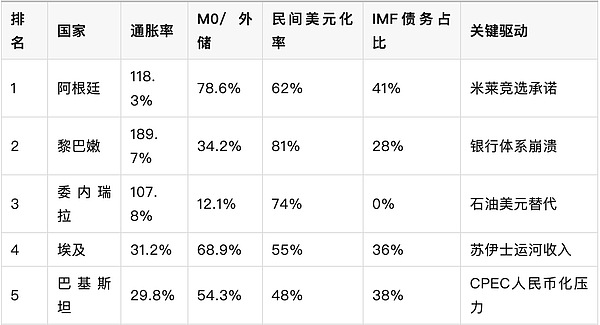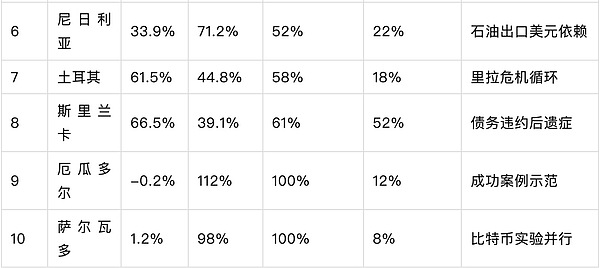
The Trump administration is actively exploring ways to promote other countries to adopt the U.S. dollar as their major currency to combat the trend of de-dollarization.The White House Council of Economic Advisers, National Security Council, National Economic Council, Treasury Department and other departments have held closed-door meetings with Johns Hopkins University professor Steve Hanke to formulate a systematic dollar promotion strategy.As an authority in the field of global monetization, Hankey has led the dollarization processes of Montenegro (1999) and Ecuador (2000), and designed the currency committee systems of Estonia, Lithuania, Bulgaria, Bosnia, and Argentina (quasi-currency committees). His views are of key reference value for understanding current policy trends.
1. Realistic assessment of the threat of de-dollarization
As of November 2025, the proportion of US dollars in global foreign exchange reserves has dropped to 58.4% (IMF COFER data, 2025Q3), further declining from the peak of 59.2% in 2021.During the same period, RMB internationalization accelerated, and the proportion of RMB payments in the SWIFT system rose to 4.12% (October 2025), doubling from 2020.In the internal trade of the BRICS+ countries, the proportion of non-USD settlements has reached 36% (Brazil Central Bank 2025 report), of which more than 95% of bilateral trade between China and Russia is settled in local currencies.
Russia’s foreign reserve dollar assets have plummeted by 78% since 2018. China continues to increase its gold holdings (the central bank’s gold reserves reached 2,312 tons in October 2025, accounting for 12.8% of its foreign reserves), and promotes RMB-denominated energy contracts in countries along the “Belt and Road”.In August 2025, Saudi Arabia settled US$50 billion of oil exports in RMB for the first time, marking the expansion of cracks in the petrodollar system.
The Trump team views this as a national security threat.The White House’s internal assessment shows that if the U.S. dollar’s reserve currency status drops below 50%, the average annual “seigniorage” savings in the U.S. will be reduced by approximately $120 billion, equivalent to 0.4% of GDP.What’s more serious is that the rise in U.S. dollar financing costs will amplify federal debt pressure – interest expenses in fiscal year 2025 have reached 1.18 trillion U.S. dollars (CBO forecast), accounting for 22.3% of federal revenue.
2. Three institutional paths for US dollar promotion
The policy framework submitted by Hanji to the government contains a three-level dollar internationalization mechanism:
1. Official Dollarization
Abolish national currencies entirely and use the U.S. dollar as legal tender, unit of account, and tax payment instrument.Currently, it has been adopted by Ecuador (2000), El Salvador (2001), Zimbabwe (partly in 2009), East Timor, Palau, and the Marshall Islands.Panama has been officially dollarized since 1904 and has not experienced a banking crisis in the past 120 years.
Advantages:
-
Eliminate the risk of currency mismatch and end hyperinflation (Ecuador’s inflation was 96% in 1999, dropped to 4% in 2001, and -0.2% in 2025).
-
Attract foreign capital to return and end the cycle of capital flight.
-
Reduce the probability of sovereign default (Panama has no default record for a century).
Implementation conditions: As long as the central bank holds enoughgross foreign exchange reservesCoverMonetary base (M0), non-net reserves are positive.The Argentine Central Bank’s gross reserves in October 2025 are approximately US$28 billion and M0 are approximately US$22 billion, which theoretically has the ability to convert.
2. Currency Board
It retains the national currency symbol but is pegged to the U.S. dollar at a fixed exchange rate, and currency issuance is 100% supported by U.S. dollar reserves.The Bulgarian Monetary Board (1997) led by Hanki linked the lev to the German mark (later the euro), and inflation dropped from 1,081% in 1996 to 1% in 1998.
Advantages:
-
Preserve the symbol of monetary sovereignty to facilitate political acceptance.
-
Enforcing fiscal discipline, the government cannot finance through central bank overdrafts.
-
Can be used as a transitional solution to dollarization.
Latest cases: In 2025, the Central Bank of Lebanon is negotiating with the United States to establish a U.S. dollar-pegged currency committee, and plans to replace the collapsed Lebanese pound with a fixed exchange rate of 1:150,000 (the black market exchange rate has reached 1:100,000).
3. Private Stablecoins (GENIUS Act Framework)
The “GENIUS Act” passed in July 2025 requires issuers of U.S. dollar stablecoins to hold 100% of U.S. Treasury bonds or cash equivalent reserves and accept supervision by the Treasury Department.As of November 2025, the total market value of stablecoins that meet the GENIUS standard will reach $286 billion (Fed data), an increase of 312% from 2024.
mechanism: For every stable currency issued, 1 US dollar of treasury bonds must be deposited to form a “private currency committee”.
fiscal effect: New demand for government bonds in fiscal year 2025 will be approximately US$110 billion, lowering the 10-year U.S. bond yield by approximately 8 basis points (calculated by Morgan Stanley).
3. Target country screening and prioritization
Hanji conducted an eight-dimensional assessment of more than 200 central banks around the world (inflation rate, foreign reserve coverage rate, capital flight index, dollarization private use rate, IMF debt proportion, political stability, regional demonstration effect, Trump’s personal relationship) and screened out 50 high-potential countries.The top ten are as follows (data as of November 2025):


Argentina priority analysis:
-
The cumulative capital flight in 2025 will reach US$177 billion (Hankey-Frank Varro model), accounting for 76% of the cumulative debt.
-
If dollarization is realized, GDP is expected to grow by 8.3% in the first year (similar to Ecuador’s 2000 effect), attracting a return capital of US$40-60 billion.
-
Although the Milley government was under pressure from the IMF to postpone the plan, Trump’s personal intervention could force the IMF to make concessions (similar to the Ecuador case in 2000).
4. Prediction of regional chain reactions
South American dominoes: Argentina’s dollarization will trigger a regional demonstration effect.
-
The private dollarization rate in Bolivia (inflation 42%) has reached 67%, and the central bank’s reserves are only enough to cover 41% of M0.
-
The Congress of Peru (inflation 38%) has launched a feasibility study on dollarization in September 2025.
-
The governor of the Brazilian Central Bank stated in October 2025 that he “does not rule out the option of a currency board.”Hankey predicts: If Argentina completes dollarization in 2026, 80% of South American countries will achieve official or quasi-dollarization by 2030.
Middle East energy anchor: If Egypt adopts a U.S. dollar-pegged currency board, the revenue from the Suez Canal (average annual US$9 billion) will be fully dollarized, driving the Gulf countries to accelerate de-renminbi.In November 2025, Kuwait has restarted negotiations with the United States to restore the dollar peg abandoned in 1961.
5. The strategic supporting role of stablecoins
Although the GENIUS Act stablecoin is not the main axis, it constitutes an important supplement:
-
microscopic penetration
In Venezuela, USDT’s daily trading volume reaches US$120 million, accounting for 0.4% of GDP, making it a de facto parallel currency.
-
technology spillover
Circle launched GENIUS-compliant USDC in 2025, with a penetration rate of 28% in Nigeria, lowering the black market premium of Naira.
-
fiscal dividend
Stable currency reserves are all invested in U.S. debt. The new demand in 2025 will be equivalent to 15% of the scale of the Federal Reserve’s QE, which effectively hedges China’s reduction in U.S. debt holdings (a reduction of US$180 billion in the first three quarters of 2025).
6. Gold’s positioning in the US dollar hegemony cycle
On November 6, 2025, the spot price of London gold was US$4,126 per ounce, an increase of 87% from the beginning of 2024.Based on the “disposable income ratio method”, Hankey predicts that the peak of the bull market will be US$6,000 per ounce, corresponding to 10% of per capita disposable income (peak level in 1980).
driving factors:
-
Geo-asset freezing cycle: Iran in 1979, Russia in 2022, and potential new freezes in the Middle East in 2025.
-
Central bank gold buying surge: In the first 10 months of 2025, global central banks purchased 1,186 tons of gold on a net basis, setting a historical record (World Gold Council).
-
U.S. Treasury credit premium: The 10-year U.S. Treasury/TIPS spread rose to 2.81%, suggesting that inflation expectations and default risks coexist.
options market signals: COMEX gold options expiring on November 24, 2025, open positions:
-
Bullish above $4,000: 8,514 ($8.514 billion)
-
Bearish below $4,000: 4,812 contracts ($4.812 billion) The call/put ratio is 1.77:1, showing that institutional bets are consolidating at the $4,000 platform.
7. Institutional obstacles and breakthrough paths
1. IMF resistance
The IMF has structural opposition to dollarization (Argentina in 2025, Ecuador in 2000 cases).But the United States, as the largest shareholder (with 16.5% of voting rights), can exert pressure through the executive board.Trump may follow Reagan’s example in the 1980s and threaten to cut U.S. investment in the IMF (a share of US$32 billion in 2025), forcing it to change its stance.
2. Central Bank Balance Sheet Obstacles
The traditional view requires net reserves to be positive, but in fact only gross reserves need to cover M0.The Lebanese Central Bank’s net reserves in 2025 will be -$42 billion, but its gross reserves will reach $18 billion, which is enough to support the 1:150,000 peg.
3. Political transaction costs
Dollarization requires the abandonment of seigniorage (approximately 1-2% of GDP).Compensation is available through:
-
The United States provides 10-year low-interest loans (similar to Bulgaria’s $600 million bridge loan in 1997).
-
Open export quotas for agricultural products (Argentine soybeans, beef).
-
Military base agreement (negotiations are restarting on the Manta base in Ecuador).
8. Constitutional Plan for Government Shutdown and Fiscal Discipline
In 2025, the U.S. federal government faces the risk of the longest shutdown in history (CBO predicts that it will last until March 2026 without an agreement).Hankey proposed the Swiss Debt Brake constitutional amendment:
-
Federal spending cannot grow faster than real GDP growth.
-
The deficit is subject to cyclical adjustment only and the structural deficit is zero.
-
The Article V constitutional convention was triggered by 36 states (34 states were required and the target was met), bypassing congressional resistance.
international mirror effect: Dollarized countries automatically implement fiscal straight jackets because they have no central bank financing channels.Ecuador’s fiscal deficit in 2025 will only account for 0.8% of GDP, and the public debt/GDP ratio is 42%, which is far better than Argentina (142%).
9. Conclusion: Structural reshaping of US dollar hegemony
The Trump administration’s dollar promotion strategy is not a zero-sum game, but a win-win situation for all parties through institutional output:
-
USA
Consolidate seigniorage, lower financing costs, and curb China’s financial expansion.
-
target country
End hyperinflation, attract capital backflow, and break the default cycle.
-
global system
Provide public goods and stabilize emerging market finance.
If Argentina takes the lead in breaking through in 2026, the wave of dollarization in South America will reshape the global currency landscape.Combining the penetration of GENIUS Act stablecoins and gold strategic reserves, the United States can stabilize the proportion of U.S. dollar reserves at more than 55% by 2030, successfully reversing the trend of de-dollarization.







